Amazon Product Ranking Guide: Strategies Based on Amazon’s Latest Algorithm
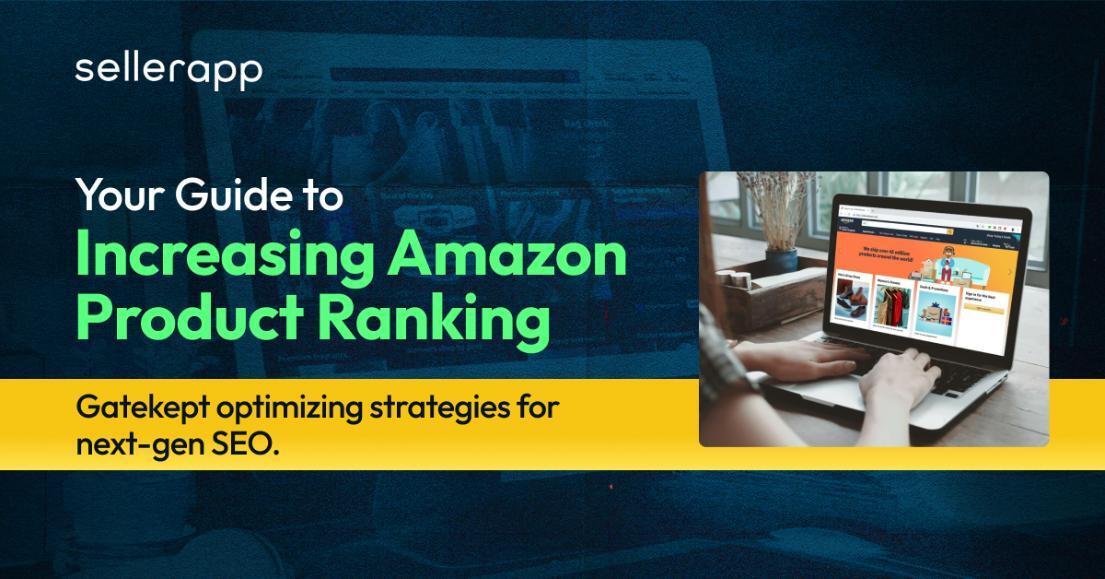
Amazon product ranking is the difference between thriving and vanishing in 2025’s ultra-competitive marketplace.
The rules to rank higher on Amazon have shifted this year. Now it’s about aligning with Amazon’s COSMO (Common Sense Knowledge Generation) algorithm (along with the A9 and A10), optimizing semantic relevance, triggering behavioral trust signals, and orchestrating cross-channel funnels (using different platforms like TikTok, Instagram, Google, or email) that feed organic lift as it boosts your product’s credibility with Amazon.
With that being said, simultaneously, you’ll have to abide by the old unchanged rules of A9 and A10, which are still very much relevant to date.
In this blog, we’ll take you through how to improve Amazon product ranking with strategies the top 1% of brands are quietly scaling, such as AMC-powered segmentation, DSP retargeting, AWD smart logistics, and getting reviews that give you correct momentum.
This isn’t another checklist but an advanced resource to understand how to rank higher on Amazon and stabilize its position for the long term while the competition plays catch-up.
Understanding what influences Amazon Product Ranking in 2025
If you’ve been wondering how to rank your products on Amazon, here’s the truth. You’re not just optimizing for one system, instead, you need to suit all 3 — the A9 Algorithm, which is still around, quietly powering the basics, the A10, which is the most practical one catching real-world signals, and COSMO, Amazon’s 2025 AI-powered search brain.
A9: The Groundwork
A9 is Amazon’s OG product ranking algorithm. Think of it as the system that makes sure your product shows up at all when someone searches. It still prioritizes keywords, especially in your titles, bullet points, and backend search terms, watches your sales history, conversion rates, and stock levels like a hawk.
In short, if you’re wondering how to rank a product on Amazon, start here by learning about A9 first (in case you’re new to this). Mastering the A9 optimization strategies gives Amazon a signal about what you’re selling, and thus, it puts you into the race.
A10: The Human Layer
Amazon realized people don’t just buy from titles, they buy from trust, engagement, and real-world signals. So, Amazon A10 favors listings with high engagement and solid behavior signals such as clicks, dwell time, and repeat purchases.
Also, it gives big brownie points to your listing if you’re driving traffic from outside Amazon like Google, TikTok, Instagram, email lists, etc.
So, optimize for behavior signals like time-on-page, add-to-cart, and reviews. Don’t chase clicks; gain customers’ trust. Wondering how to rank products high on Amazon without overspending on ads? A10 loves consistency, so focus on experience to boost Amazon product ranking.
On the contrary, it punishes poor experiences, which are prominent from high returns, misleading listings, and bad reviews. So, if you’ve been asking how to improve product ranking on Amazon, this is your behavioral checklist. A10 watches what buyers do and judges your product listings accordingly.
COSMO: The Advanced Algorithm
COSMO is the next gen Amazon algorithm that does not just read what buyers type; it understands what they mean, matching buyers’ intent, not just search terms. It is driven by semantic content like natural language, FAQs, and benefit-first bullets.
It adjusts rankings in real-time based on how shoppers interact with your product pages. This may come off as something new, but write like you’re solving someone’s problem if you want to improve Amazon product ranking.
Answer their unspoken questions, maybe use visuals, storytelling, and video. Want to know how to get your product ranked higher on Amazon and make people care? COSMO rewards intent-first content. This means content that feels like it was written for the person, not the algorithm.
The recent addition of Rufus AI to Amazon’s interface is in a way related to COSMO. Rufus surfaces COSMO-ranked results with conversational context, and when you optimize for COSMO, you futureproof the future performance of your current listings.
Let’s take a look at some of the major factors that influence how to rank your product on Amazon.
SEO Optimization for higher organic Amazon product ranking
If you think “how to rank products high on Amazon” means cramming keywords everywhere, you need to keep yourself abreast with Amazon’s best practices.
Amazon has evolved.
The game isn’t about stuffing. It’s about smarter SEO, and that means mastering semantic relevance, strategic keyword research, and dynamic listing optimization.
1. Master keyword relevance
Instead of piling on the obvious keyword (“vegan protein powder”), think wider. What about “Plant-based protein powder” or “Dairy-free protein powder”? These related phrases are called semantic relevance.
Don’t overlook the backend keywords. No matter how the algorithms have changed, backend keywords are still relevant. Those hidden gems get you discovered without cluttering your listing.
Use all 250 bytes wisely to boost Amazon product ranking, include common misspellings, Spanish translations, if you serve bilingual customers, and niche low-volume terms. Just don’t repeat yourself, as Amazon can spot keyword stuffing a mile away.
If you sign up for the SellerApp dashboard, head over to the Product Intelligence tool, and you get a variety of options to include, that too without ever repeating yourself.
You get to choose by relevance, assessing their search volume and CPC, checking if your products are indexed (by copy-pasting your back-end keywords), and checking the overall listing performance. There, we made your journey a little easier with our free index checker tool.
Want to know how to rank your products high on Amazon? Constantly test your keywords with A/B experiments. This dynamic approach keeps your listing fresh and conversion-optimized.
2. Deep dive into keyword research
The foundation of how to rank products on Amazon lies in thorough keyword research. You can’t improve Amazon product ranking without knowing what your buyers search for. Grab tools like SellerApp, or Amazon Brand Analytics (if you’re brand-registered) to dive deep into the search term reports.
These help you spot:
- Short-tail keywords (broad but super competitive)
- Long-tail keywords(usually 3+ words that are more specific, lower competition, higher buy intent)
Both of which are equally important to target different types of buyers. When you filter keywords by their conversion rates and relevance, don’t just chase volume; chase buyers ready to pull the trigger. And that is where you need to use your ppc budget carefully.
Let’s say you’re selling a “tattoo practice skin” on Amazon.
You start by pulling search term reports using SellerApp or Amazon Brand Analytics. Here’s what you find:
Short-tail keyword: “tattoo skin” with 20,000+ monthly searches, but ultra-competitive.
Long-tail keyword: “tattoo practice skin for beginners” with 2,300 monthly searches, low competition, and high conversion rate.
Now, instead of pouring your entire PPC budget into the high-volume “tattoo skin” keyword (which might burn cash fast), you allocate more to the long-tail keyword that’s attracting people ready to purchase and know what exactly they want.
You also add supporting long-tail phrases like “fake skin for tattooing” and “tattoo skin A4 sheet” into your listing copy, bullet points, and backend keywords.
So when you monitor your performance, you will see that you’ve started ranking for less competitive, high-converting terms, while gradually building relevance for the broad match keywords.
You’re putting more of your budget toward keywords that actually result in sales, not just clicks. This increases your TACoS efficiency and feeds Amazon’s A9/A10 algorithm more “conversion signals.”
How to use those high-intent keywords across your listing for boosted Amazon product ranking?
- For Title: Include the highest-converting long-tail term.
- For Bullets: Add contextual long-tails (e.g., “suitable for rotary & coil machines”).
- For Description/A+ Content: Reinforce use-cases (e.g., “perfect for apprentices perfecting line work”). Voice search queries embedded in A+ text can supercharge discoverability.
- Backend Keywords: Cover spelling variations, synonyms, and Spanish/other regional terms.
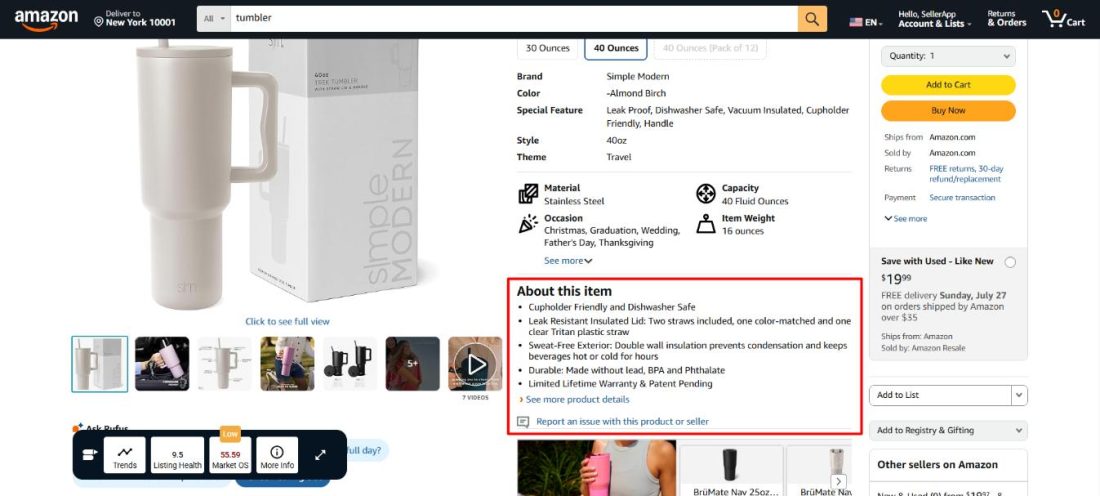
In this way, you build relevance around buyer intent.
Top tip: Target verified long-tail keywords with >20% CVR and low top-3 seller dominance.
But why low top-3 seller dominance?
This means the top 3 sellers ranking for that keyword don’t completely dominate the sales or visibility.
So, there’s room for new sellers or your product to rank well and capture meaningful sales. High dominance usually means those top sellers have a very strong hold, making it hard to compete.
3. Craft titles that speak Amazon’s language and yours
Your product title is the headline of your entire listing, so make it count.
Tell customers exactly what they’re getting, including product type, brand name, key features (size, color, material), benefits (why it’s better than the rest), and aim for clarity over clutter. Here, an AI title generator can also be helpful here, assisting you in brainstorming variations that strike a balance between being search-friendly and easy to read for humans.
Around 60 characters is ideal, even though Amazon lets you go longer to 200.
A/B test your titles to understand how to unlock the perfect mix of search-friendly and click-worthy.
For example, take the product Ashwagandha Gummies.
A bad title would be “Ashwagandha Gummies Stress Relief Gummies Natural Supplement Vegan Herbal Ashwagandha Vitamin for Sleep Anxiety”, which is keyword dense, repetitive, unclear and most importantly, doesn’t flow like a human sentence.
In short, it tries to say too much and says too little convincingly.
A good title would be somewhat like “CalmNest Ashwagandha Gummies –Vegan Stress Relief & Sleep Support with Zinc & B12”
Why does this work?
It explains what it does, and the brand name is prominent. This adds credibility and brand recall. Product type, “Ashwagandha Gummies” is stated clear and upfront, along with primary benefits i.e. “Stress Relief & Sleep Support” which targets high-intent searches.
Keywords “with Zinc & B12” show differentiators and added value. Overall, it feels like a headline a human wrote.
In addition, it’s around 80 characters, thus easy to read on mobile; still loaded with relevance.
Take a look at how our PPC experts have done it.
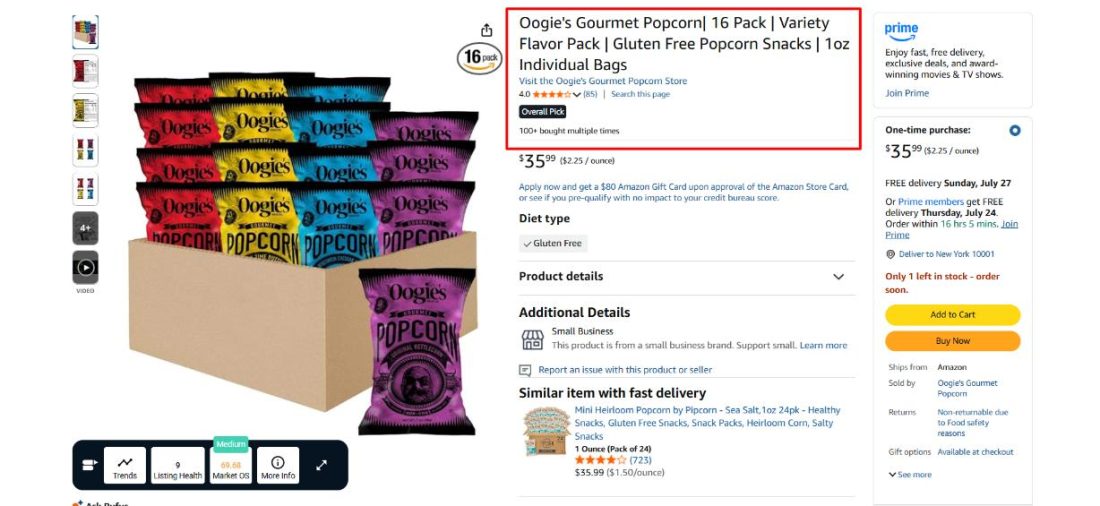
4. Bullet points that sell (Without keyword overkill)
Amazon bullet points are your chance to shine. Lead with benefits that matter to your customers. Keep each point short (think under 100 characters), clear, and impactful.
You want your bullets to do two things:
- Answer “What’s in it for me?”
- Slip in keywords naturally.
Remember, customers scan bullets, so keep it concise.
5. Descriptions that tell your brand story
This is your moment to address your customer’s pain points. Use conversational language and stories to connect emotionally. Sure, weave in your secondary and long-tail keywords.
However, never sacrifice readability. Amazon is smart enough to catch keyword stuffing and flag the listings with stuffed keywords as it affects customer experience.
6. Backend keywords
You’ve got 500 characters (which was previously 250) to sprinkle in all the synonyms, abbreviations, foreign language terms, and misspellings that don’t fit anywhere else.
No commas or semicolons here, just space-separated, lowercase, relevant keywords.
And in case you want to sieve through your backend keyword list and remove the punctuations from the keywords, simply head over to the SellerApp dashboard, track your product, add your backend keywords from Amazon Seller Central, and tick ‘remove special characters’.

Pro tip: Avoid repeating keywords you already use in your visible content. This space is typically used to boost discovery for search terms that are used repeatedly but grammatically incorrect, so they don’t belong in the listings. So, segregate front and back-end keywords accordingly.
So, you can use SellerApp’s duplicate keyword remover tool to remove repetitive keywords; in case you have any.
7. Get Brand Registered: The game changer for how to rank products high on Amazon
If you want to seriously improve Amazon product ranking, Brand Registry is non-negotiable (Especially if you own a private label brand).
It offers:
- A+ Content: for rich images and enhanced descriptions that convert better.
- Brand Analytics: for laser-focused insights into customer behavior.
- Sponsored Brand Ads: for targeted advertising with more control.
- Amazon Attribution: for tracking external traffic that boosts rankings.
- Amazon Storefronts: to build a branded shopping experience inside Amazon.
- Brand Referral Bonus: earn while you grow your brand.
8. More tips for COSMO-ready listings
Ready to take notes on how to rank high on Amazon search? Here are more tips to help you stand out and sell smart on Amazon.
Use “Enhance My Listing”
Rolled out mid-2024, Amazon’s built-in AI tool rewrites your listing copy using buyer-focused language. According to early reports, it can increase performance by up to 40%, just by rephrasing for shopper intent.
Write like your customer talks
Want to know how to rank high on Amazon search? Try thinking like your customer:
“How do I clean a nonstick pan?” or “Best vitamin C serum for oily skin”
Use them naturally in your titles, bullet points, product description, and especially A+ content.
Sharper listing with alt-tag SEO
Alt-text on images matter a lot. Text-only modules rank better than all-image layouts.
Want to improve product ranking on Amazon?
Give your A+ content a semantic facelift. Alt-text is invisible to your shoppers, but Amazon’s indexing bots see every word. From late 2024, Amazon confirmed that A+ Content image alt-tags are now crawlable, meaning they directly impact your product’s discoverability.
Add real, scannable descriptions. Fill your image alt-tags with keyword-rich summaries. No more “Image 1.jpg.”!
Product & Offer Optimization for higher Amazon product ranking
If you’re serious about learning how to rank your products on Amazon, here’s a truth bomb. Great SEO and ads alone won’t get you there. The product itself and how you package it matter way more than most sellers realize.
Before you obsess over keyword stuffing or PPC bids to boost Amazon product ranking, invest time in what your customers actually want. That’s what product and offer optimization is all about.
To improve Amazon product ranking,
- Find the gaps your competitors missed
You want to how to rank a product on Amazon that’s not just another face in the crowd, right? Start by looking closely at what others are missing. Dive into competitor reviews, especially the negative ones. Assess what features customers are complaining about. Are there common requests or pain points that no one’s addressed?
This is exactly your market gold mine. It’s where opportunity lives.
You’re entering the wireless earbuds market, and the competition is fierce. But look closer, the top listings are packed with 1-star reviews saying the same things:
- “Battery dies in 2 hours.”
- “They hurt after 30 minutes.”
- “Keeps disconnecting mid-call.”
- “Not even splash-proof.”
For instance, you end up building earbuds that last 12 hours on a single charge. You make the fit ergonomic and customizable. You ensure stable Bluetooth performance. You seal it with ‘IPX7 water resistance’.
Then you lead your listing with these exact solutions.
By fixing what others ignore, you become the product people wish the others were. That’s how you rank and convert.
Bundle, improve, differentiate
Now that you see what’s missing, think bigger. Sellers these days stay updated about these best practices, and they put them into practice. So, how to beat them in this game and differentiate? How can you rank products high on Amazon by giving customers something fresh? So, try bundling complementary items for better value?
Can you improve product quality or add unique features? Maybe a new variant, a color, size, or material nobody else offers?
These changes make your listing stand out in Amazon’s crowded marketplace.
That’s how you validate demand like a pro. You don’t want to guess if there’s a market for your improved product; you want data. Tools like SellerApp Product Opportunity Explorer and keyword analytics tell you:
- How many people search for your product or related items
- How fierce the competition really is
- Where the demand is trending
This data-driven approach is the foundation of how to rank products on Amazon with confidence.
Build a Value Proposition That Launches (Before SEO or Ads)
Once you’ve uncovered gaps, crafted a killer offer, and validated demand, it’s time to nail your value proposition. This is the promise you make to your customers by narrating why they should buy your product over anyone else’s.
Before you start fiddling with keywords or sinking money into ads for better Amazon product ranking, get crystal clear on what makes your product unmissable.
Amazon’s ranking algorithm rewards products that deliver real value and delight customers. The better your offer, the higher your conversion rate, the more sales velocity you build, and the better your organic ranking.
Optimize them until they speak to your buyers’ hearts, then let SEO and ads do the rest. Then, watch how much easier it is to improve Amazon product ranking because you built it on rock-solid foundations.
Visual Content Strategy: The Untapped Power Move to Rank Products High on Amazon in 2025
You can pour all your efforts into keyword mining, finding backend terms, and increasing ad bids, but if your visuals fall flat, be ready for a low conversion rate.
Amazon shoppers don’t read first; they scan. Your images and videos are your real storefront window. If you’re serious about how to rank products high on Amazon, you can’t afford to treat them like an afterthought.
Here’s how your visual content becomes the reason your product ranks higher, converts better, and sells faster.
Nail the image basics (or risk getting buried)
Amazon’s algorithm has zero chill about image quality. You need zoom-enabled, clean, 1000×1000 px photos with white backgrounds. That’s baseline eligibility for Amazon product ranking.
Amazon tracks how people interact with your listing and high-res visuals that let shoppers zoom in, read labels, and inspect details, driving more clicks and longer dwell time. Both combined will result in better Amazon product rankings.
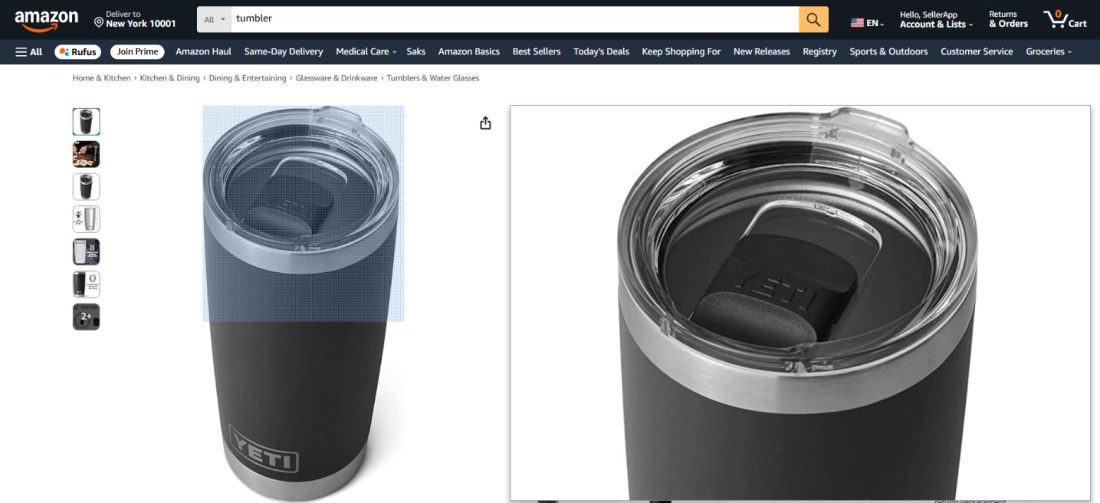
Think of your main image as your handshake. If it’s weak, most people won’t stick around for the conversation.
Build an image stack that sells (and signals relevance)
You’re not just uploading pretty pictures when you’re aiming Amazon product ranking. You’re building intent-driven visual layers that help Amazon understand (and trust) your product. Want to know how to rank your products on Amazon? Try these best practices to improve the visuals.
- For Lifestyle images, show real humans using your product in context.
- For scale shots, let people see how big or small the product is.
- For infographics, overlay 3–5 key features with brief copy so skimmers still get your value.
- Before/after visuals are perfect for beauty, wellness, cleaning, or repair categories.
- Variation images can be used to showcase every color, size, or pack type.
The better the clarity, the fewer returns.
These images are also teaching COSMO (Amazon’s 2025 semantic engine) what your product really is. That’s how to rank your product on Amazon with context-first precision.
Add AR, 360° or 3D to your advantage
Want to go where your competitors haven’t? Go interactive. Amazon is replacing legacy 360° images with 3D product models in eligible categories like furniture, tools, and home goods. One recent Amazon beta test showed a +14% boost in CVR for listings with 3D viewers.
If your product qualifies, it’s a no-brainer.
Interactive images lead to more engagement, which gives out stronger behavioral signals, ultimately boosting your Amazon product ranking.
Add Videos
If a picture is worth a thousand words, a 15–30 second video is worth your next ranking jump. Amazon now gives extra ranking weight to listings with embedded video content, especially in the A+ module or media gallery. Why? Because video increases dwell time. It answers objections. It boosts trust. It reduces returns.
Your video doesn’t need Spielberg-level editing. It just needs to show your product in action, explain what it solves, include voice search-friendly phrases like “How do I clean a nonstick pan?” and that’s all to make it significantly more effective than your competitor’s listing.
Advanced PPC Strategies: Turning Clicks Into Amazon Product Ranking Edge
If you’re serious about how to rank products high on Amazon, your ad strategy can’t just be about throwing money at broad-match keywords and praying. PPC is no longer just pay-to-play; it’s pay-to-learn, segment, and scale.
We will break down exactly how advanced sellers are using Amazon PPC to fuel their Amazon product ranking growth. With:
- Hybrid launch strategies,
- AMC-powered insights, and
- Correct ppc ad structure.
Use Amazon Marketing Cloud (AMC) Like a Ranking Weapon
Amazon Marketing Cloud (AMC) gives you buyer journey clarity you won’t get anywhere else.
Here’s how smart brands use it to improve Amazon product ranking:
- NTB Targeting (New-to-Brand): Build campaigns that target users who have never purchased from your brand. AMC helps you identify where they entered the funnel and why they didn’t convert.
- Cross-ASIN Influence Mapping: Understand how views on one product affect conversion on another. Use this to shape A+ modules and cross-sell ads.
- Time-Lag Retargeting: Know how many days between an ad click and conversion. Set DSP to follow your buyer across the web with high-ROI reminders at the exact delay interval.
Use AMC + SellerApp’s Audience Analytics to layer this insight with demographic data and repeat-purchase behavior, especially useful for consumables, wellness, and home goods.
| What’s New in Amazon PPC Ad for 2025 Amazon is rolling out quiet but game-changing enhancements: Sponsored Products (B2B Targeting): Target procurement professionals, bulk buyers, and business accounts with specific messaging and tiered offers. These clicks convert higher and rank faster due to volume boosts. Sponsored Brands with NTB Uplifts: Amazon now allows bid multipliers for New-to-Brand conversions. You can pay more only when gaining new customers, ideal for launch scaling without wasted spend. |
PPC Campaign Blueprint
The most successful ad accounts use segmentation as a scaling system.
1. Match type layering
- Exact Match: Use for high-intent, proven converting terms. These drive your search-to-sale efficiency, which COSMO favors for organic ranking boosts.
- Phrase Match: Use for mid-intent modifiers (e.g., “best hair oil for men”). These bring context, and with higher CVR, feed the ranking engine well.
- Broad Match: Use for discoverability and backend indexing, but always negative-match irrelevant terms weekly.
2. Keyword Group Segmentation
Separate campaigns by:
- Branded Keywords – Low ACOS, high ROAS. Keep isolated to monitor brand health.
- Generic Keywords – Competitive, high CPC. Use to drive discovery and rank for broader terms.
- Competitor Keywords – Bid aggressively, but watch conversion closely. Pair with strong comparison images.
- Long-Tail Keywords – Low-volume but high-converting. Especially critical in niche categories.
Use SellerApp’s automation tool to pause poor-performing keywords upon hitting a set threshold and adjust bids based on CVR and TACoS.
Placement Modifiers: Target Top of Search, Intelligently
Amazon allows bid adjustments by placement with more granularity. For keywords with high CTR but low organic rank, boost Top-of-Search (TOS) bid by 50–100% to secure real estate and fuel COSMO’s visibility scoring.
For product pages or rest-of-search placements, reduce bids unless they’re part of your competitor conquest strategy.
Hybrid Launch Strategy: Dominate the First 30 Days
Your launch is the only time Amazon will give you algorithmic grace; use it wisely.
Pre-Launch: Quiet Awareness + Keyword Research
- Set up low-bid auto + broad match manual campaigns to gauge search terms and page-view behavior.
- Run external influencer traffic (Meta, TikTok) to build pre-sale momentum, tagged with Amazon Attribution for retargeting via AMC.
Launch Phase: Aggressive Targeting + Visibility Surge
- Activate exact-match campaigns at max allowable CPC for priority keywords. Watch for 20–30% TACoS targets in Week 1.
- Run Sponsored Brands video and A+ linking campaigns to increase session depth (a COSMO engagement signal).
Post-Launch: Retarget & Expand
Use DSP and AMC custom audiences to re-engage non-converting clickers. Segment by page visitors. abandoned carts and previous buyers of other ASINs. Then launch sequential retargeting creatives across display and video.
Let’s say you’re selling ergonomic office chairs.
You’ve driven a solid stream of traffic, but conversions are stalling. Here’s how to get your Amazon product ranking moving again using DSP and AMC.
Start by tapping into Amazon Marketing Cloud to segment your traffic into key buckets:
- shoppers who viewed your listing but didn’t add to the cart,
- abandoned-cart visitors, and
- buyers of your other ASINs.
These segments represent untapped potential, and AMC lets you isolate them with laser precision.
Now activate Amazon DSP to re-engage each segment with tailored retargeting campaigns.
Show page visitors lifestyle creatives that build trust (“Why 92% of customers feel better after 7 days”), nudge abandoned carts with urgency-based video ads (“Still thinking about it? Your chair’s waiting. $15 off today”), and upsell previous buyers with dynamic product placements that bundle related SKUs.
Use sequential messaging to guide them back. Limit impressions to avoid fatigue, run tests by region and time of day, and track performance uplift directly through AMC.
Brand Authority: Why Ranking on Amazon Now Starts With Ownership, Not Just Optimization
You can have the sharpest bullets, the slickest title, and the most perfectly priced offer. But if you’re not a recognized brand in Amazon’s eyes, you’re still playing from the sidelines.
Amazon Brand Registry makes you an VIP in the eyes of the Algorithm.
Think of Brand Registry as unlocking your seller superpowers. Without it, you’re just another storefront. With it, you’re a protected brand. You get ownership over your listings, titles, images, A+ content, and even enhanced brand story modules.
You get first-party tools like Amazon Attribution and Brand Analytics, most importantly, algorithmic preference.
Brand-registered listings rank better. Not because they’re labeled but because they convert better, they build trust faster, and they have access to tools that feed Amazon exactly what it wants i.e, performance signals.
Use Brand Analytics Like a Spyglass
Once you’re in the registry, Amazon gives you a view of the battlefield. Brand Analytics unlocks keyword-level insights.
You can see what search terms customers used before clicking, which ones led to sales, and which ones your competitors are dominating.
Use the Search Query Performance dashboard to find high-converting terms with low brand penetration.
- Build content around them.
- Bid smart.
- Optimize only what matters.
Brand Analytics gives you data not just on what’s popular but on what’s working. That’s what COSMO wants. Relevance and real-world signals.
Sponsored Brand Video Ads: CTR as a Ranking Signal
Here’s something that hasn’t changed in 2025. Clicks still matter, yet not all clicks are equal.
Amazon now places video ads directly in search results, pushing static listings further down.
The best-performing Sponsored Brand Video campaigns aren’t just winning ads, they’re feeding back into organic rank.
These ads drive CTR. CTR drives conversions. Conversions boost ranking. And it starts with Brand Registry. If you’re wondering how to get your product ranked higher on Amazon, this is the quickest way to move fast.
Drive External Traffic (and Let Amazon Reward You for It)
Through Amazon Attribution, you tag campaigns across Google, Meta, TikTok, and email for your products to boost Amazon product ranking. Amazon connects the dots and credits your listings for external performance.
For every sale driven from outside Amazon using these tags, you get a percentage back in referral fees. There’s more.
The COSMO algorithm favors listings with healthy external traffic. These are seen as authoritative, trusted, and in demand. This is how you can fuel your Amazon product ranking.
Elevate Your A+ Content into a Ranking Engine
In 2025, A+ Content isn’t decorative. It’s crawlable, indexed, and measurable. Amazon now indexes certain A+ text areas and alt-tags from images.
So, if your A+ images don’t have keyword-optimized alt text, you’re not meeting the optimal ranking potential.
If you’re still using image-only modules, you’re being algorithmically deprioritized.
Good A+ content answers buyer questions before they’re asked. It reduces bounce rate and increases dwell time.
Build Amazon Store that Feeds Your Funnel
Amazon gives you a brand website ecosystem that is embedded into the Amazon URL, but nothing short of a fully functional branding platform.
Your Brand Store is your official landing zone inside the marketplace. It’s customizable, modular, and linkable from Sponsored Brand Ads and off-Amazon campaigns.
Why does it matter for ranking? It increases time-on-site. It clusters your products in one branded environment. If you’re serious about how to rank a product on Amazon and sustain long-term visibility, your Brand Store is the bedrock of that journey.
External traffic leverage to boost Amazon product ranking
If you’re serious about learning how to rank higher on Amazon, you need to go beyond your product page. Relying on the basics is outdated, engineering demand outside Amazon and sending it in is the way to boost your Amazon product ranking.
So if you’ve been Googling “how to get your product ranked higher on Amazon” without paid traction, here’s what you need to focus on external traffic with attribution.
Set Up Amazon Attribution (The Smart Way)
If you’re running ads on TikTok, Meta, Google, or even just email newsletters, but not tagging them with Amazon Attribution links, you’re not making the most out of the tools available to grow your Amazon product ranking.
Amazon Attribution is your visibility engine. It tells you which channel brought in the click, the add-to-cart, and the final sale. It feeds the algorithm with real buyer data, and directly boosts your organic Amazon product ranking because Amazon loves off-site demand.
Hot tip? Pair this with the Brand Referral Bonus (maybe a 10% referral fee rebate), and you’ve just built a growth loop that funds itself.
Build funnels that actually rank your product
To really improve your Amazon product ranking, build structured funnels that guide your buyer:
Cold traffic from social ads goes to a warm-up page (Amazon Storefront or pre-sell landing page). Then comes the conversion push with an Attribution-tagged Amazon link. Finally, layer in retargeting with Amazon DSP or Sponsored Display to catch bounced traffic.
As a result, you get more qualified traffic, better conversion rates, and stronger rankings. That’s how to rank your product on Amazon without chasing the algorithm.
Activate Your Website as a Ranking Asset
If you already have a Shopify or WooCommerce site, it’s a good opportunity to turn your business into a passive ranking machine.
Here’s how.
Link every blog post, email, or product comparison to your Amazon listings using deep links with attribution. Even low-volume traffic becomes a signal booster. You build brand authority off Amazon, while your rankings climb on Amazon.
If you’ve been wondering how to rank your products on Amazon or why your listings aren’t sticking on Page 1, this is your edge.
Here’s one of the best-kept secrets to get your Amazon product ranking up organically.
Structure your site around high-intent keywords that your Amazon audience is also searching for. Refer to the search terms.
Use tools like Semrush, Ahrefs, or even Google Search Console to find long-tail, high-buying-intent keywords like: “Best vitamin C serum for dark spots”. “Non-toxic toddler lunch kits”. “Tattoo practice skin for rotary pens”
Next, deep-link that content straight to your Amazon listing with Attribution. You’ll rank on Google, convert on Amazon, and amplify search rank and Amazon product ranking simultaneously.
This is how to rank a product on Amazon while playing outside Amazon’s walls.
Customer Experience Optimization: The Invisible Hand Behind Amazon Search
Make every post‑purchase moment algorithm gold. Amazon’s COSMO now treats buyer happiness like a ranking currency. Check below for an advanced playbook top brands use to improve Amazon product ranking without touching bids or bullets.
Track the Metrics Amazon Cares About
| KPIs | Why It Matters for Amazon Product Ranking | Expert Benchmark |
|---|---|---|
| Order Defect Rate (ODR) | Anything > 1 % flags risk; COSMO throttles visibility and Buy Box exposure. | Aim < 0.5 % (pro sellers per Seller Central forum anecdotes). |
| Perfect Order % (POP) | POP mixes on‑time delivery, no refunds, no messages. High POP lifts trust weighting. | 95 %+ unlocks internal eligibility to boost Amazon product ranking. |
| Return Rate | Rising returns = expectation mismatch → ranking penalty + fee hike. | Keep < 8 % in soft goods; < 3 % in hardlines. |
| Review Velocity | Consistent drip > spikes. COSMO favors steady momentum. | 1 – 2 % of monthly unit sales converting to reviews. |
Respond to Every Q&A
The Q&A widget is fully indexed, which means each answer can surface on voice search. Drop conversational phrases like “Yes, this fits a 13‑inch laptop” to capture intent queries and quietly rank your products high on Amazon for fringe keywords others ignore.
Flip Negatives into Ranking Positives
90‑Minute Rule: Reply to 1‑ and 2‑star reviews within 90 minutes. Fast responses act as a reassurance to onlookers.
Root‑Cause Macro: Tag complaint themes in Excel, then update listing copy or A+ modules monthly, closing the feedback loop that COSMO monitors through reduced returns.
Automated Nudges: Use SellerApp’s Review Request tool to trigger reviews at the moment customer satisfaction peaks. It is when the product’s value becomes tangible.
For instance, send the review request on Day 7 for skincare, when users see visible results. Or Day 30 for patio furniture, after seasonal setup. This cadence isn’t arbitrary. COSMO monitors when reviews occur. Predictable, well‑timed review growth signals long-term buyer satisfaction and reinforces product trustworthiness.
Tips for FBA sellers:
- Track returns via the Returns Performance dashboard.
- Use Amazon Voice of the Customer reports to identify common issues before they escalate.
Tips for FBM sellers:
- Respond within 24 hours.
- Use templates that are warm, professional, and solve issues fast.
Every touchpoint feeds Amazon’s view of you as a seller. Treat it like reputation capital that influences how to rank products high on Amazon.
Inventory & Pricing Strategy: The Silent Push Behind Amazon Product Ranking.
Still wondering how to rank products high on Amazon with just stellar operations? Pricing and inventory optimization is the kind that speaks directly to Amazon’s algorithm.
Use Dynamic Repricing Tools to Win the Buy Box (and the Algorithm)
Winning the Buy Box is like being center stage in Amazon’s theatre. You get more visibility, more conversions, and most importantly, more favor with the algorithm. COSMO considers price velocity and responsiveness, so if you’re undercutting the noise without racing to the bottom, you win relevance points and conversion share.
Want to know how to rank your products on Amazon without guessing? Plug in a repricer and let it do the heavy lifting.
Ramp-Up Pricing: Launch to Win, Not to Profit
This might feel counterintuitive, but here’s the secret top sellers swear by:
To rank a product on Amazon, you don’t chase profit in the first week; you chase velocity.
- Launch with a 10–20% discount compared to the market average.
- Combine this with solid review generation and social proof, then gradually raise your price after establishing traction.
- COSMO now tracks pricing over time and uses early purchase velocity as a proxy for market demand.
The quicker you prove buyers want your product, the faster Amazon pushes you toward Page 1. That’s how to get your product ranked higher on Amazon.
Inventory Management is the Insurance for Consistent Ranking
Want to see your product disappear from search? Just let it go out of stock for a few days.
Amazon watches your inventory health like a hawk. If it senses inconsistency, your Amazon product ranking will silently tank, even if everything else is optimized.
Follow these tips to stay up in the Amazon product ranking:
- Use Amazon Warehousing & Distribution (AWD) to ensure you’re always stocked, even if FBA throws you a restock curveball.
- Monitor your FBA restock limits. When you’re capped, so is your discoverability.
- Integrate tools like SellerApp’s Inventory Forecasting Module to maintain a buffer and avoid overstocking (which can lower profitability and Amazon Inventory Performance Index score).
If you’re asking how to rank your product on Amazon, don’t overlook what’s in your warehouse.
Price Smart, With Buyer Psychology and Amazon Rules in Mind
Amazon’s 2025 algorithm values price-to-value alignment just as much as low pricing.
- Use psychological pricing ($19.95 > $20) to drive higher click-through rates (CTR) and conversion rates (CVR).
- Bundle intelligently. Go beyond “value stack,” maybe a “combo pack.” COSMO understands perceived value now, not just SKU count, so play along.
- A/B test different price points using Manage Your Experiments to find your listing’s sweet spot for conversion and ranking.
This is advanced territory, but this is how you rank products high on Amazon without racing to zero margin.
The Sentiment Strategy: Using Reviews to Boost Your Amazon Product Ranking
Currently, Amazon product ranking is no longer just about keyword density or ad spend. It’s about how well your product resonates. Thus, reviews are one of the most powerful resonance signals you’ve got.
How Reviews Shape Amazon’s Search Algorithm (Yes, Even COSMO)
Amazon’s latest AI engine, COSMO, doesn’t just consider review counts but reads the content as well. It detects emotion and compares what customers say to what your listing promises. If you’re trying to figure out how to rank products on Amazon, start here:
- Do your reviews echo your bullet points?
- Do they highlight the same benefits your title mentions?
- Are they recent, steady, and emotionally positive?
If the answer is yes, COSMO sees your listing as trustworthy, relevant, and conversion-worthy, everything it needs to rank your products high on Amazon search.
Advanced Strategies to Improve Amazon Product Ranking via Sentiment Analysis
If your goal is to keep your Amazon Product Ranking high, make sure to follow these tips.
1. Activate Amazon Vine Strategically
Use Amazon Vine to gather early, unbiased reviews but only after your listing is optimized. The goal isn’t volume, it’s insight. Monitor the language used and update your copy to mirror it.
Stagger Vine enrollments across product variants to test which ones customers connect with most. That’s your ranking advantage.
2. Use NLP Review Analysis to Rewrite Your Listing
Pull out:
- Common praise points to a boost in bullet #1.
- Frequent confusion can be added as an element to the image infographics.
- Emotional wins can be woven into A+ content.
This is how you rank your products on Amazon with precision, not guesswork.
3. Mirror Review Language in Your Copy
If your top reviews constantly mention “stays cold for hours,” but your listing says “double-wall insulation,” you’ve got a semantic mismatch.
Customers are telling you what matters in their language. Your job is to mirror it back in your bullets, title, and A+ content. That’s how you align with COSMO’s semantic relevance engine and boost your Amazon product ranking organically.
4. Monitor Review Health Like a KPI
Track these consistently to stay on top of Amazon product ranking:
| Metric | Why It Matters |
|---|---|
| Avg. Rating | Impacts conversion + Buy Box trust |
| Sentiment Trends | COSMO ranks a positive emotional tone |
| Review Velocity | Signals popularity + satisfaction |
| Recency | Fresh reviews = active product engagement |
If you’re not measuring these, you’re not managing your Amazon product ranking.
This is how you can lower return rates, higher CTRs, and stronger buyer trust, all of which help rank your product on Amazon faster.
Track What Matters: Data for Amazon Product Ranking Power
In this case building a live, always-on dashboard powered by SellerApp’s ecommerce data API tells you exactly how your listing is performing, why it’s losing visibility, and what to fix next.
Here’s how data-driven brands are turning Amazon Brand Analytics and native dashboards into their Amazon product ranking edge:
Amazon Brand Analytics
We’ve spoken about Amazon Brand Analytics before. You can further use it to
Identify your ASIN’s share of clicks for specific search terms, compare performance vs competitors using Search Frequency Rank (SFR) and Top 3 Click Share.
Focus on “Search Query Performance” to pinpoint keywords driving sales, cart adds, and conversions. This is the gold standard for improving Amazon product ranking in 2025.
Manage your experiments
Want to know how to improve product ranking on Amazon without wasting ad budget? Split test like a pro. Inside Brand Registry, use ‘Manage Your Experiments’ to A/B test.
For Product titles: Test keyword-led vs benefit-led formats.
For A+ Content modules: Test emotional storytelling vs technical specs.
COSMO loves listings that continuously improve based on real-world buyer behavior. Sellers who test monthly tend to see +20–40% lift in click-through rates which makes it a major lever for how to rank higher on Amazon.
Business Reports + Category Benchmarks
Amazon product ranking is also about your performance relative to your category.
Use Business Reports to monitor:
- Session percentage share to check if more shoppers are seeing your listing?
- Unit session percentage (CVR) to check if they are converting?
- Page Views vs Buy Box percentage to check if you’re missing sales due to pricing or stock issues?
Then, use category benchmarks (found in Seller Central and Brand Analytics) to validate your numbers against market averages. This is how top 1% brands improve Amazon product ranking without second-guessing.
Final Thoughts: How to continuously adapt to nail Amazon Product Ranking
If you’ve made it this far, you already Amazon product ranking is about planning systematically according to these best practices. Sellers who win over the current algorithm are the ones who adapt relentlessly.
Here’s how to future-proof your strategy:
- Track COSMO algorithm updates like your rankings depend on it, because they do. Semantic search, real-time feedback signals, and session depth are now non-negotiables.
- Audit Amazon policy changes every month. A single update to image rules, A+ modules, or inventory thresholds can knock your listing off Page 1.
- Automate what slows you down, like, repricing, restock planning, and sentiment tagging, so your team can stay focused on strategy, not spreadsheets. SellerApp can curate custom business reports on inventory fluctuations, pricing forecast, and so on, just in case you prefer data precision, as you should!
- Monitor category trends through Brand Analytics and peer benchmarks. Check out BSR ranks using the SellerApp Chrome Extension. Then, convert those BSR numbers into actionable sales data with our Free Amazon Sales Estimator to understand exactly how many units top-ranking products sell per day in your category. If your segment is shifting toward eco-friendly bundles or lower AOV fast-movers, you’ll want to pivot before competitors outpace your positioning.
If you’re still wondering how to improve product ranking on Amazon, the answer is building systems that adapt faster than the algorithm can shift.
And of course, using every post-sale signal, keyword insight, and behavioral trend to evolve before your competitors even notice the change. Because, according to recent Amazon updates, visibility isn’t earned once; it’s earned every day.
A parting tip: Don’t chase BSR. Chase Search Rank. You could be top-selling in your category and still buried in a search for a specific keyword. So, remember, great listings sell more, as they get discovered more, which improves BSR anyway.
Additional Read:
Amazon FBA Inspection: A Comprehensive Guide


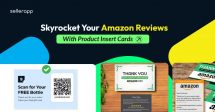
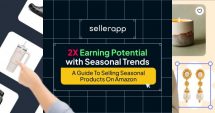



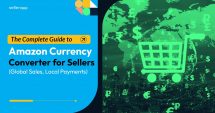
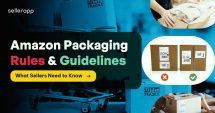
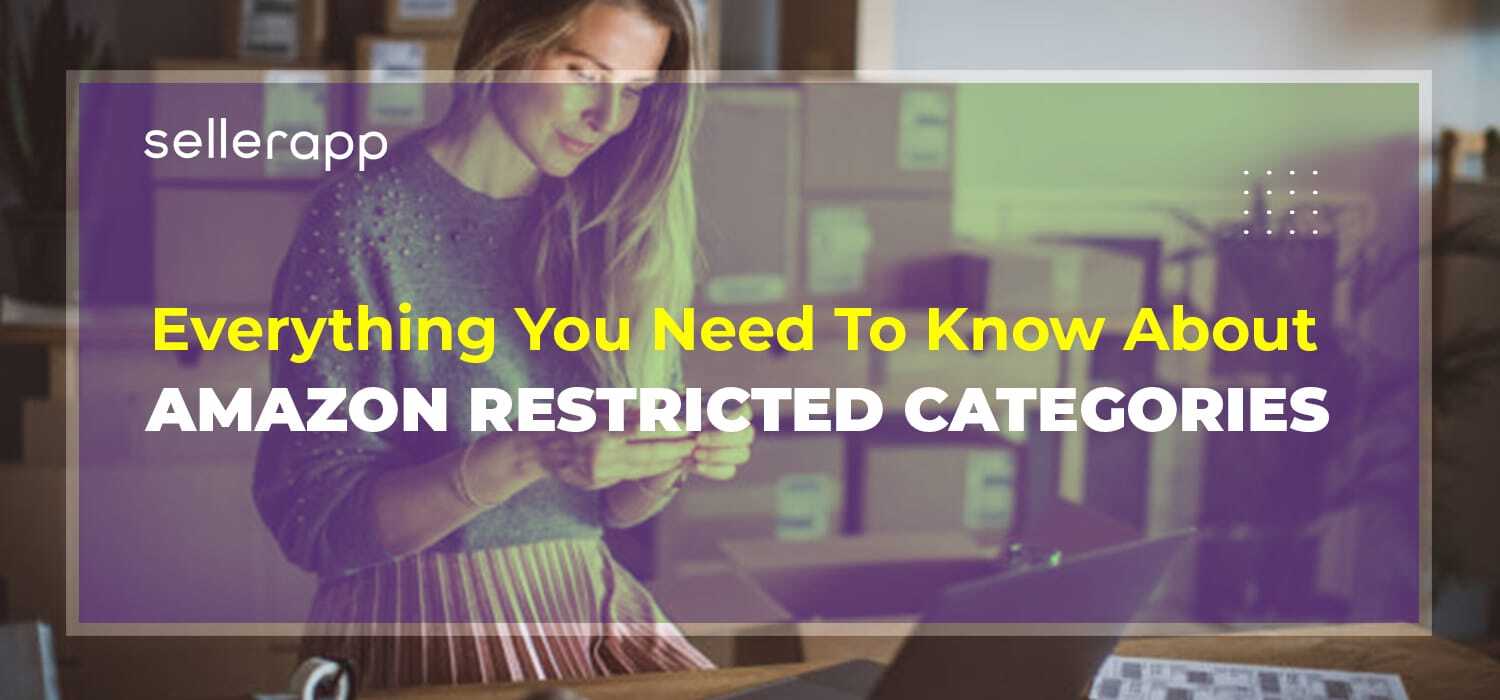
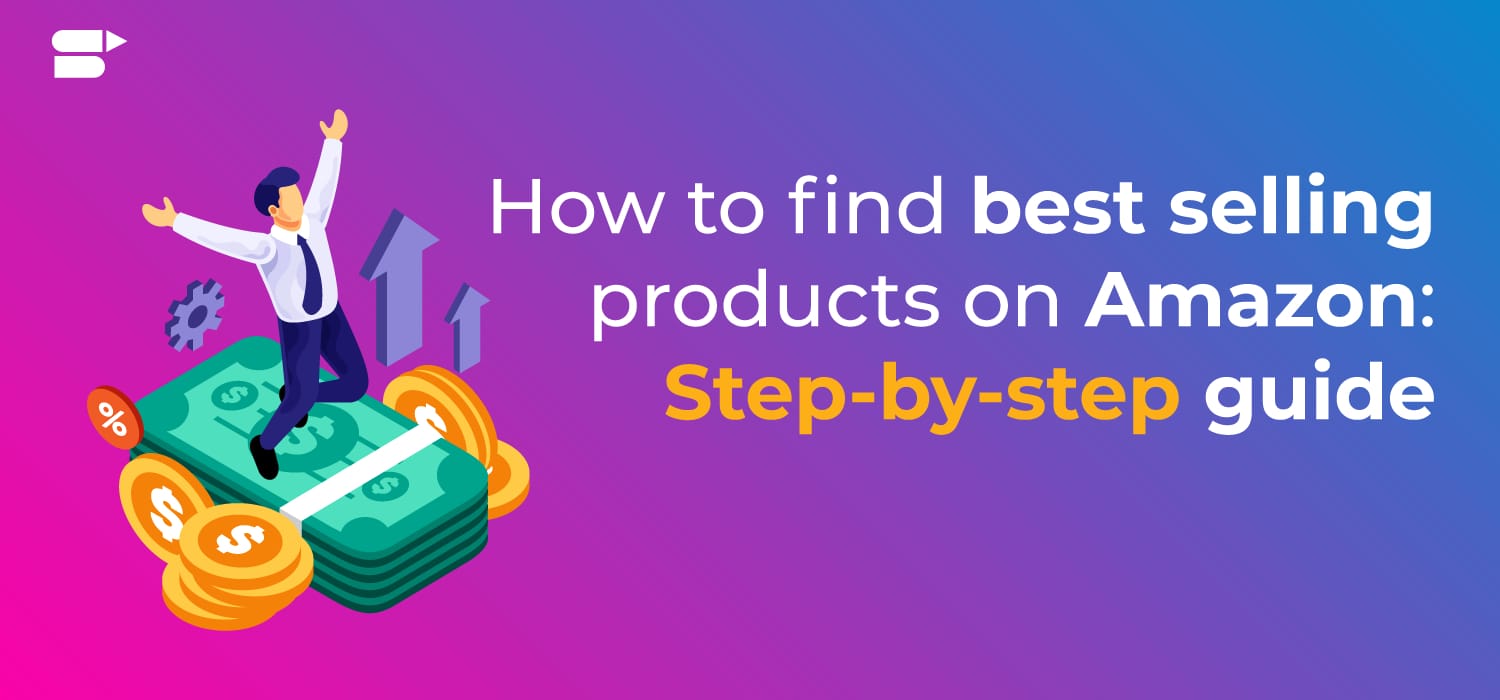
Aubrey Crawford
September 2, 2025Overall, this is more than just a “how-to rank” post — it’s a strategic playbook for staying relevant as Amazon’s algorithm evolves.
Caleb Russell
September 5, 2025Using AMC, DSP, and cross-channel funnels as ranking tools—not just ad tools—is a smart take; it aligns marketing with organic lift.
Bella Hunt
September 6, 2025The visual content strategy section is underrated — high-quality images & videos that support storytelling are a powerful, often overlooked ranking lever.
James Taylor
September 8, 2025I also appreciate the reminder that frequent stockouts or order issues can kill your ranking, no matter how good your SEO is.
Penelope Stephens
September 10, 2025Mentioning Rufus AI and conversational search was interesting — I hadn’t realized Amazon is already surfacing results in more “human-like” contexts.
Austin Hoffman
September 11, 2025Great emphasis on behavioral signals like dwell time, add-to-cart, and repeat purchases — Amazon is clearly prioritizing customer engagement more than ever.
Dewayne Redgate
September 11, 2025Seeing external traffic (Instagram, TikTok, email) being called out as a ranking lever for A10 really opened my eyes — I’d been focusing only on internal Amazon optimization.
Mason Bryant
September 14, 2025The tip about constantly experimenting with backend keywords and new semantic phrases is super actionable — something I’ll start testing this week.
Adam Spencer
September 14, 2025I love how you stress the importance of external traffic and behavioral signals, it’s not just about keywords anymore.
Natalie Jenkins
September 15, 2025Excellent breakdown, combining COSMO, A10, and the classic A9 frameworks really clarifies how ranking is evolving.